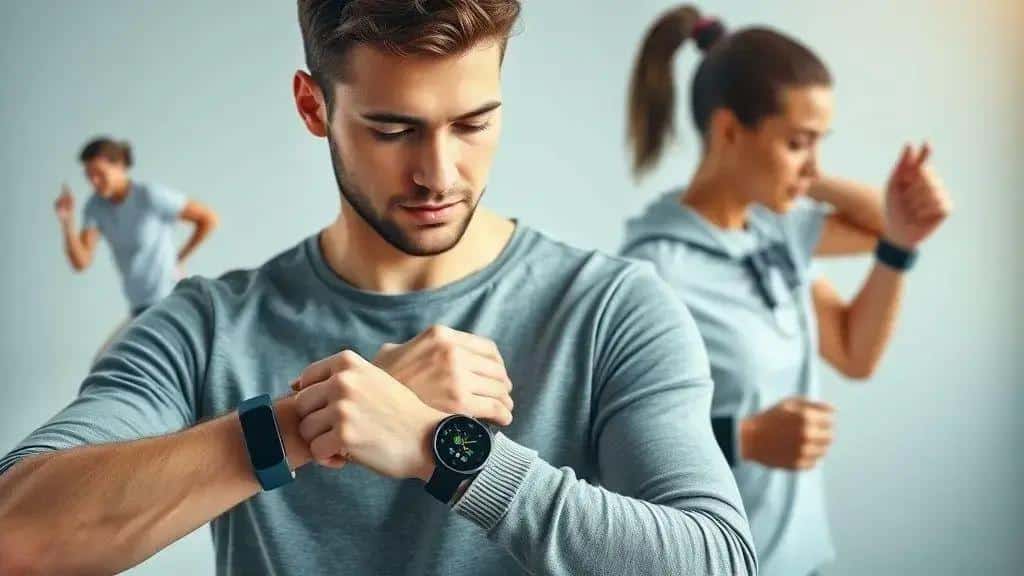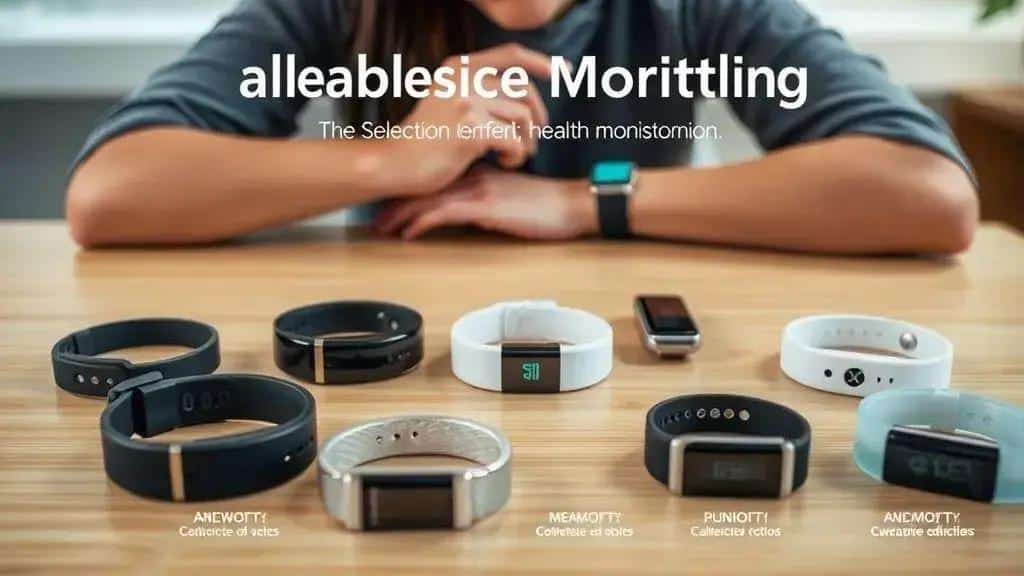Wearable health monitoring devices: your next health ally

Wearable health monitoring devices are essential tools that track vital metrics like heart rate and activity levels, empowering users to improve their fitness and overall health through real-time feedback and personalized insights.
Wearable health monitoring devices are transforming the way we approach our health. Imagine having real-time insights about your well-being right on your wrist! This technology not only tracks our fitness levels but can also provide critical health alerts. Let’s dive into this fascinating world.
What are wearable health monitoring devices?
Wearable health monitoring devices have become a popular trend in our journey towards improved health. They provide valuable insights right from our wrists or bodies, helping us stay informed about our well-being.
These devices can track various health metrics, including heart rate, sleep patterns, and physical activity. Understanding what they offer can empower you to make better health choices.
Types of Wearable Health Devices
There are several types of wearable health monitoring devices, each designed to serve specific purposes:
- Smartwatches that track fitness and health stats.
- Fitness bands that monitor activity levels and calories burned.
- Health monitors focusing on vital signs like blood pressure.
- Smart clothing that provides data on muscle activity and posture.
Each of these devices brings unique features to the table, enhancing our ability to monitor our health. For instance, smartwatches often combine multiple functionalities, allowing for continuous heart rate monitoring, notifications, and even guided workouts.
On the other hand, fitness bands are specifically designed for tracking daily activities and encouraging users to stay active. They are lightweight and often more affordable, making them accessible for many.
Why Use Wearable Health Devices?
The reasons for using wearable health monitoring devices are compelling. They promote self-awareness, motivating users to adopt healthier habits. By seeing real-time data, individuals can make conscious adjustments to their routines.
Moreover, these devices can also alert users to potential health issues. For example, if a person’s heart rate spikes unexpectedly, the device can prompt them to seek medical advice. This proactive approach to health can potentially prevent serious complications.
With so many advancements in technology, staying ahead of your health has never been easier. Wearable health monitoring devices allow for a personalized health journey, tailoring insights to individual needs.
Key benefits of using wearable health devices

Using wearable health devices can greatly enhance your approach to personal health. These devices offer real-time insights that motivate individuals to make healthier choices.
One significant benefit is the ability to track your physical activity effortlessly. Wearable devices monitor steps taken, calories burned, and even the intensity of workouts. This kind of data encourages a more active lifestyle.
Monitoring Vital Signs
Wearable health devices also allow for the continuous monitoring of vital signs. You can keep an eye on your heart rate, sleep patterns, and even stress levels with just a glance at your wrist. This kind of monitoring provides feedback that can be crucial in managing your overall health.
- Real-time heart rate tracking for better fitness.
- Sleep quality analysis to enhance rest.
- Stress alerts to promote relaxation techniques.
With this information, users can make informed decisions about their health habits. For instance, if you notice that your heart rate spikes during certain activities, you can adjust your routine accordingly.
Encouraging Healthy Behaviors
Wearable health devices are also great for fostering consistency in fitness routines. Many devices come with reminders to move, encouraging you to stay active throughout the day. This helps combat sedentary behavior, which is a common issue in today’s lifestyle.
Using these devices can turn your health journey into a fun challenge. Some wearables offer competitions, allowing you to engage with friends and family. This social aspect can increase motivation and commitment to fitness goals.
Additionally, these devices often integrate with apps that provide personalized recommendations based on your data. This feature can further support users in achieving their health goals efficiently.
How wearable devices promote health and fitness
Wearable devices are revolutionizing how we approach health and fitness. By providing real-time information, these gadgets empower users to take control of their health journeys.
One of the primary ways they promote health is through activity tracking. Most wearable devices can monitor steps taken each day, allowing users to set and achieve daily fitness goals easily. This feedback encourages people to stay active throughout their day.
Gamification of Fitness
Many wearable devices incorporate gaming elements into fitness, which makes working out more enjoyable. By turning exercise into a challenge, users are motivated to beat their previous records or compete with friends.
- Step challenges that pit users against their friends or family.
- Badges and rewards for hitting fitness milestones.
- Daily reminders to stay active and move regularly.
This gamification transforms exercise into an interactive experience, making it less of a chore and more of a fun activity to look forward to.
Health Tracking Features
Wearable devices also track vital health metrics, such as heart rate and sleep quality. This detailed health monitoring enables users to understand how their bodies are functioning. For instance, knowing your heart rate during exercises can help you find the ideal intensity for your workouts.
Additionally, wearables often provide insights into sleep patterns. Good sleep is crucial for overall health, and these devices can suggest adjustments to improve sleep quality, such as recommending changes to bedtime routines.
Through these features, wearable devices create a comprehensive picture of individual well-being. As users gain insights from the data, they can make informed decisions regarding diet, exercise, and lifestyle choices.
Tips for choosing the right device for you

Choosing the right wearable health monitoring device can be a daunting task. With so many options available, it’s important to identify what features matter most to you. This guide will help you make an informed decision.
First, consider what health metrics you want to monitor. Some devices focus on basic activity tracking, while others provide advanced features like heart rate monitoring and sleep analysis. Knowing your fitness goals will help narrow down your choices.
Check Compatibility
Another key factor is device compatibility. Many wearable devices sync with smartphones, so make sure the device you choose works with your operating system. Some brands have specific app ecosystems, enabling a seamless connection to your health data.
- iOS compatibility for Apple users.
- Android support for a range of devices.
- Check for app integration with fitness platforms.
Additionally, think about the design and comfort of the device. You will likely wear it throughout the day and night, so it should feel comfortable and stylish. Look for features like adjustable bands and lightweight materials.
Evaluate Battery Life
Battery life is another important consideration. Some devices require daily charging, while others can last for several days or even weeks. Choose a device that matches your lifestyle, ensuring that you can keep it running without constant recharging.
Research user reviews and ratings to see how different devices perform in real-world usage. This feedback can provide insights into durability and functionality that specifications alone may not reveal. A device that fits your needs perfectly is also a device you will use consistently.
Finally, set a budget for your new wearable health monitoring device. Prices can vary significantly based on features and brand. Establishing a budget can help you narrow down options and find a device that best fits your needs without overspending.
FAQ – Frequently Asked Questions about Wearable Health Monitoring Devices
What are wearable health monitoring devices?
These are gadgets that can track various health metrics, such as heart rate, steps, sleep patterns, and more, often worn on the wrist.
How do I choose the right wearable device for my needs?
Consider factors like the health metrics you want to track, device compatibility with smartphones, comfort, battery life, and your budget.
Can wearable devices really improve my fitness?
Yes, they provide real-time feedback on your activity level, encourage healthy habits, and help you set and achieve fitness goals.
Are wearable health devices suitable for everyone?
Most devices cater to a wide audience; however, specific features may be more beneficial for particular fitness levels or health conditions.





